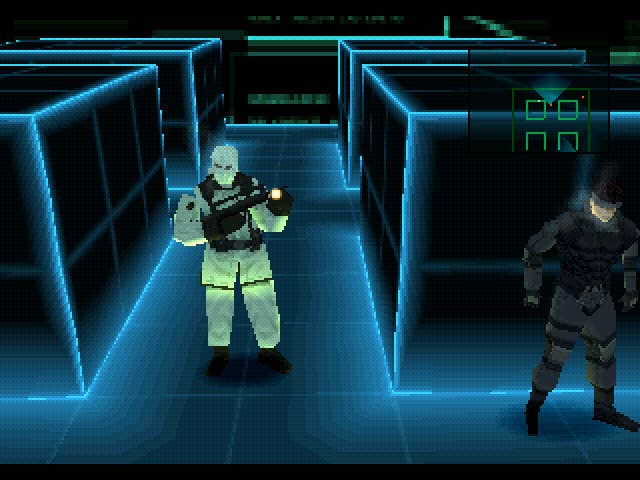Virtual Spotlight: Metal Gear Solid VR Missions
The original Metal Gear spin-off is still an addictive treat.
This article first appeared on USgamer, a partner publication of VG247. Some content, such as this article, has been migrated to VG247 for posterity after USgamer's closure - but it has not been edited or further vetted by the VG247 team.
The PS1 Archives section of PlayStation Network has been all but abandoned for the past year or so; I assume no one sees the point in it anymore (besides Gung Ho's oddball import shovel ware) what with the promise of magical Gaikai of streaming archives out there in the ether. And yet, from out of nowhere, here comes a random addition to the section... and a pretty great one at that.
Metal Gear Solid VR Missions debuted as a bonus disc in a Japanese rerelease of the original Metal Gear Solid back in 1999. Since Americans are generally a lot less willing than their Japanese peers to pay full price to buy a game a second time just to get some extras, Konami broke the bonus disc out as a separate budget retail release for the U.S. Given its origins, you can understand why VR Missions doesn't really play like a "proper" Metal Gear game in its own right; rather than telling a new story or presenting a cohesive adventure, it's simply an elaboration on the virtual reality training modes that players could use to get accustomed to Metal Gear's complexities. More recent games just have codec calls where Snake's advisors break the fourth wall to dole out instructions. I kind of preferred the old way.

VR Missions focuses entirely on the stealth and combat mechanics of Metal Gear; it's wholly action-focused and broken into dozens of standalone missions. There's a certain amount of irony in the game, since the original Metal Gear Solid had the best narrative and clunkiest game mechanics in the series -- yet here's a a companion piece that plays down the former while emphasizing the latter. Sounds like a recipe for failure, right? You might think so, but I'd actually argue that VR Missions is much more enjoyable to play than its legendary counterpart.
The appeal of VR Mission comes from the fact that it focuses entirely on the quirks and idioms of Metal Gear Solid. Where the play of the original game sometimes sits at odds with its desire to tell a cool story in organically designed environments and situations, VR Missions strips away all of that to present a series of short, specific objectives built around Snake's skills and weapons. It's about one step removed from a minigame collection, but because every challenge employs skills taken from the normal context of Metal Gear Solid's story, it all feels natural and cohesive.

If nothing else, VR Missions offers a means by which to explore facets of the original game that many players may never have experimented with. The Metal Gear series emphasizes stealth and non-lethal play, and in the older games that meant the "proper" way to play was to sneak around and avoid engaging in combat except where necessary. Here, you can dicker around with the "wrong" style of play and see the potential inherent in that arsenal Snake carries around but doesn't really use much.
Missions are grouped according to difficulty, style of play, and weapon focus. Some are more difficult than others -- the fixed camera angles and clunky controls don't help, and we've come a long way in interface design for indirect weapons like grenades in the past 15 years -- but VR Missions is loads of fun. It's a great example of designers bending a game system to its limits, pushing it beyond the bounds of what was possible within the constraints of the story-driven game experience. (I could write a whole thesis here about the nature of game design and how narrative constructs hinder mechanical purity and undermine the medium, but I'll let you off the hook for now.)

Where VR Missions is at its best is in its most advanced stages, which uphold Metal gear's tradition of storytelling in reverse. Rather than bending mechanics to fit the mold of a larger story, these standalone sequences squeeze little nuggets of plot into little play-based scenarios. Whether you're solving a murder mystery or battling giant genome soldiers, these advanced missions pose tricky challenges and are fun -- fun in the wacky, this-is-ridiculous way we love Hideo Kojima for -- without being bogged down by long Codec speeches and all the other baggage that comes with Metal Gear games. And at the end of it all, the rewards for mastering the game are a small selection of missions in which you play as cyborg ninja Grey Fox (paving the way for Raiden's turn in Sons of Liberty) and a photo mode in which you can linger a little too long on the boxy anatomy of PS1-quality ladies (which is a little too silly to be creepy, but certainly acted as a belwether for some of today's more unsavory treatment of women in games).
I realize it can be a little tough to revisit Metal Gear Solid due to how poorly some of its controls and interface elements have aged, but VR Missions shows the game's underpinnings at their very best. Removed from awkward environments and long-winded cutscenes that you have to sit through repeatedly every time you die against a boss, Metal Gear Solid proves to be a lot of fun even to this day.
ConclusionIt's a shame the series has moved away from VR missions as bonus content; as Metal Gear's mechanics improve over time, these bite-sized action-driven sequences would even more fun. But even in this blocky, still-sorting-out-how-3D-works incarnation, slinking around as Snake for its own sake remains totally entertaining.








.jpg?width=291&height=164&fit=crop&quality=80&format=jpg&auto=webp)